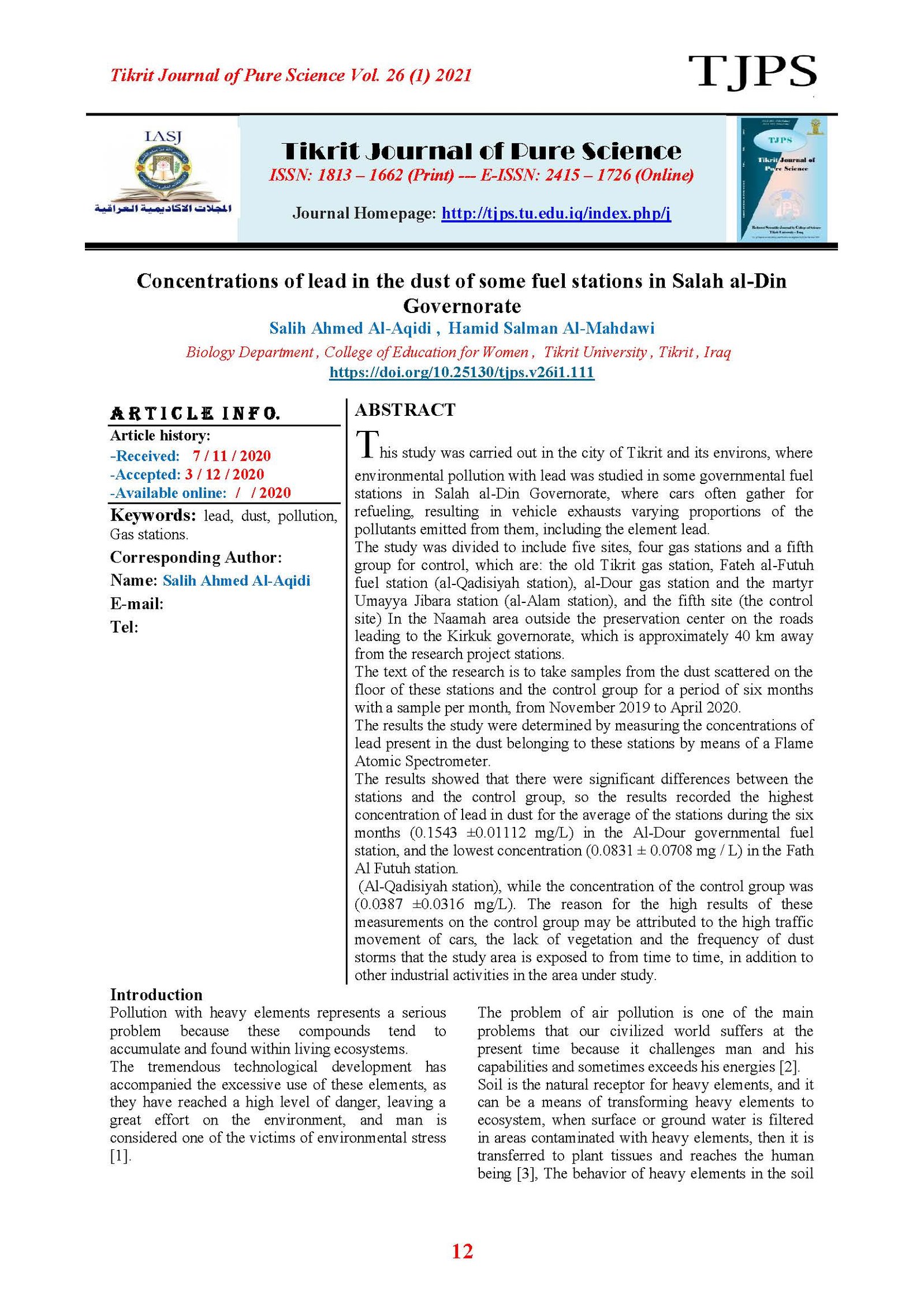Concentrations of lead in the dust of some fuel stations in Salah al-Din Governorate
Main Article Content
Abstract
This study was carried out in the city of Tikrit and its environs, where environmental pollution with lead was studied in some governmental fuel stations in Salah al-Din Governorate, where cars often gather for refueling, resulting in vehicle exhausts varying proportions of the pollutants emitted from them, including the element lead.
The study was divided to include five sites, four gas stations and a fifth group for control, which are: the old Tikrit gas station, Fateh al-Futuh fuel station (al-Qadisiyah station), al-Dour gas station and the martyr Umayya Jibara station (al-Alam station), and the fifth site (the control site) In the Naamah area outside the preservation center on the roads leading to the Kirkuk governorate, which is approximately 40 km away from the research project stations.
The text of the research is to take samples from the dust scattered on the floor of these stations and the control group for a period of six months with a sample per month, from November 2019 to April 2020.
The results the study were determined by measuring the concentrations of lead present in the dust belonging to these stations by means of a Flame Atomic Spectrometer.
The results showed that there were significant differences between the stations and the control group, so the results recorded the highest concentration of lead in dust for the average of the stations during the six months (0.1543 ±0.01112 mg/L) in the Al-Dour governmental fuel station, and the lowest concentration (0.0831 ± 0.0708 mg / L) in the Fath Al Futuh station.
(Al-Qadisiyah station), while the concentration of the control group was (0.0387 ±0.0316 mg/L). The reason for the high results of these measurements on the control group may be attributed to the high traffic movement of cars, the lack of vegetation and the frequency of dust storms that the study area is exposed to from time to time, in addition to other industrial activities in the area under study.
Article Details

This work is licensed under a Creative Commons Attribution 4.0 International License.
Tikrit Journal of Pure Science is licensed under the Creative Commons Attribution 4.0 International License, which allows users to copy, create extracts, abstracts, and new works from the article, alter and revise the article, and make commercial use of the article (including reuse and/or resale of the article by commercial entities), provided the user gives appropriate credit (with a link to the formal publication through the relevant DOI), provides a link to the license, indicates if changes were made, and the licensor is not represented as endorsing the use made of the work. The authors hold the copyright for their published work on the Tikrit J. Pure Sci. website, while Tikrit J. Pure Sci. is responsible for appreciate citation of their work, which is released under CC-BY-4.0, enabling the unrestricted use, distribution, and reproduction of an article in any medium, provided that the original work is properly cited.
References
[1] Ariffin, N. ; Abdullah, M. M. ; Zainol, M. R. ; Murshed, M. F. ; Zain, H. ; Faris, M. A. and Bayuaji, R. (2017). Review on Adsorption of heavy metals in wastewater by using geopolymer: 10.1051.
[2] Abu Raheel A. H. M.; Jabr, H. M. (2016). "Spatial distribution of some air pollutants in Hilla." Journal of the Literature of Kufa 1.29, 11-38.
[3] Dixit, R.; Malaviya, D.; Pandiyan, K.; Singh, U.B.; Sahu, A.; Shukla, R.; Singh, B.P.; Rai, J.P.; Sharma, P.K.; and Lade, H. (2015). Bioremediation of heavy metals from soil and aquatic environment: An overview of principles and criteria of fundamental processes. Sustainability, 7, 2189–2212. [CrossRef].
[4] Abdel Moneim, E.M.; and Al-Turki A. B.I. (2012). Heavy elements are their sources and harmful to the environment. Center for Promising Research in Biological Control and Agricultural Information. Al Qussaim University. Saudi Arabia.
[5] Rashid, R. T.; Mansour, H. S. (2013). "Estimating the percentage of soil pollution at the University of Technology with lead metal." Journal of Engineering and Technology, Volume 31, Issue 5 Part (B) 108-113.
[6] Sa, I.; Costa, M. J. P. and Cunha, E. M. (2012). Lead hepato toxicology :study in an animal model .Toxicol.Ind.Health.28:108-113.
[7] Holstege, C. P. (2010). Toxicology recall. Lippincott Williams& Wilkins, Philadelphia.
[8] Weaver, V.; lee, B.; Ahn, K.; lee, G.; Todd, A.; Stewart, W. W.; Simon, D. P. and Pj, S. (2017). association of lead biomarkers with renal function in korean lead workers. occup environ med 2003 : 60:551-562.
[9] Martin, S.; Griswold; (2009). Human health effects of heavy metals. Environmental science and technology briefs for citizens. 785-532-6519.
[10] Khalid. Y.; Salih, B. M. and Issaq, M. W. (1981). Lead contamination of soil in Baghdad city, Iraq. Bull. Envirin. Contac. Toxicol. Vol(27). p:634-638.
[11] Al-Sahhaf, F. H. (1989). Applied Plant Nutrition. House of Wisdom, University of Baghdad, Ministry of Higher Education and Scientific Research. The Republic of Iraq.
[12] Rasul, I. A. (2016). "Basra Governorate Air Quality Assessment." Journal of the College of Education for Girls, 27 (3).
[13] Mohammed, A. B.; Mahdi, A. H. and Muhammad, H. M. (2015). Assessment some heavy elements pollution in dust of Kirkuk city, Iraq. Kirkuk University Journal-Scientific Studies, 10(4), 195-208.
